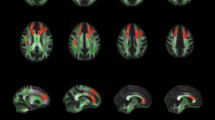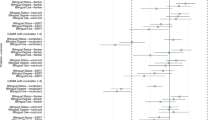Abstract
The sustained use of two languages by bilinguals has been shown to induce broad changes in language and cognitive abilities across the lifespan. The largest changes are seen as advantages in executive control, a set of processes responsible for controlled attention, inhibition, and shifting. Moreover, there is evidence that these executive control advantages mitigate cognitive decline in older age and contribute to cognitive reserve. In this paper, we examine some of the evidence for these findings and explain their relation to bilingual language use. These effects are considered in terms of their implications for our understanding of cognitive and brain plasticity. Some implications for social policy are discussed.
Zusammenfassung
Der kontinuierliche Gebrauch beider Sprachen bilingualer Menschen hat sich als Anstoß für weitreichende Veränderungen der sprachlichen und kognitiven Fähigkeiten über die Lebenszeit erwiesen. Als bedeutendste Veränderungen werden Vorteile bei der exekutiven Kontrolle gesehen, also eines Systems von Prozessen, das verantwortlich ist für die Kontrolle der Aufmerksamkeit, das Setzen von Zielen und Prioritäten oder das Initiieren und Sequenzieren von Sprachhandlungen. Es gibt starke Hinweise darauf, dass die Vorteile der exekutiven Kontrolle auch eine Abschwächung des Abbaus kognitiver Fähigkeiten im Alter zur Folge haben und zur Ausbildung der Fähigkeit des Gehirns beitragen, Schädigungen zu überwinden kann. In unserem Beitrag setzen wir uns mit Forschungsergebnissen zu diesen Problemen auseinander und erläutern die Zusammenhänge, die sich mit bilingualem Sprachgebrauch zeigen. Die entsprechenden Effekte werden unter dem Gesichtspunkt betrachtet, welche Implikationen sich für das Verstehen kognitiver und neuronaler Plastizität ergeben. Ferner werden gesellschaftspolitische Implikationen angesprochen.
Similar content being viewed by others
References
Abutalebi, J., & Green, D. W. (2007). Bilingual language production: The neurocognition of language representation and control. Journal of Neurolinguistics, 20, 242–275.
Abutalebi, J., Miozzo, A., & Cappa, S. F. (2000). Do subcortical structures control language selection in bilinguals? Evidence from pathological language mixing. Neurocase, 6, 101–106.
Abutalebi, J., Della Rosa, P. A., Green, D. W., Hernandez, M., Scifo, P., Keim, R., Cappa, S. F., & Costa, A. (2012). Bilingualism tunes the anterior cingulate cortex for conflict monitoring. Cerebral Cortex, 22, 2076–2086.
Baker, C. (2011). Foundations of bilingual education and bilingualism (5th ed.). Clevedon: Multilingual Matters.
Barac, R., & Bialystok, E. (2012). Bilingual effects on cognitive and linguistic development: Role of language, cultural background, and education. Child Development, 83, 413–422.
Bennett, D. A., Wilson, R. S., Schneider, J. A., Evans, D. A., Mendes de Leon, C. F., Arnold, S. E., Barnes, L. L., & Bienias, J. L. (2003). Education modifies the relation of AD pathology to level of cognitive function in older persons. Neurology, 60, 1909–1915.
Bialystok, E., & Barac, R. (2012). Emerging bilingualism: Dissociating advantages for metalinguistic awareness and executive control. Cognition, 122, 67–73.
Bialystok, E., & Luk, G. (2012). Receptive vocabulary differences in monolingual and bilingual adults. Bilingualism: Language and Cognition, 15, 397–401.
Bialystok, E., Craik, F. I. M., & Freedman, M. (2007). Bilingualism as a protection against the onset of symptoms of dementia. Neuropsychologia, 45, 459–464.
Bialystok, E., Craik, F. I. M., & Luk, G. (2008). Cognitive control and lexical access in younger and older bilinguals. Journal of Experimental Psychology: Learning, Memory, and Cognition, 34, 859–873.
Bialystok, E., Martin, M. M., & Viswanathan, M. (2005). Bilingualism across the lifespan: The rise and fall of inhibitory control. International Journal of Bilingualism, 9, 103–119.
Bialystok, E., Peets, K. F., & Moreno, S. (2012). Producing bilinguals through immersion education: Development of metalinguistic awareness. Applied Psycholinguistics. doi:10.1017/S 0142716412000288.
Bialystok, E., Craik, F. I. M., Green, D. W., & Gollan, T. H. (2009). Bilingual minds. Psychological Science in the Public Interest, 10, 89–129.
Bialystok, E., Luk, G., Peets, K. F., & Yang, S. (2010). Receptive vocabulary differences in monolingual and bilingual children. Bilingualism: Language and Cognition, 13, 525–531.
Costa, A., Hernández, M., & Sebastián-Gallés, N. (2008). Bilingualism aids conflict resolution: Evidence from the ANT task. Cognition, 106, 59–86.
Craik, F. I. M., Bialystok, E., & Freedman, M. (2010). Delaying the onset of Alzheimer’s disease: Bilingualism as a form of cognitive reserve. Neurology, 75, 1726–1729.
Ebert, T., Pantev, C., Rockstroth, B., Taub, E., & Wienbruch, C. (1995). Increased cortical representation of the fingers of the left hand in string players. Science, 270, 305–307.
Fabbro, F., Skrap, M., & Aglioti, S. (2000). Pathological switching between languages following frontal lesion in a bilingual patient. Journal of Neurology, Neurosurgery, and Psychiatry, 68, 650–652.
Francis, W. S. (1999). Analogical transfer of problem solutions within and between languages in Spanish-English bilinguals. Journal of Memory and Language, 40, 301–329.
Gebauer, S. K., Zaunbauer, A. C. M., & Möller, J. (2013). Cross-language transfer in English immersion programs in Germany: Reading comprehension and reading fluency. Contemporary Education Psychology, 38, 64–74.
Gold, B. T., Kim, C., Johnson, N. F., Kryscio, R. J., & Smith, C. D. (2013). Lifelong bilingualism maintains neural efficiency for cognitive control in aging. Journal of Neuroscience, 33, 387–396.
Gollan, T. H., Montoya, R. I., & Werner, G. A. (2002). Semantic and letter fluency in Spanish-English bilinguals. Neuropsychology, 16, 562–576.
Gollan, T. H., Fennema-Nostestine, C., Montoya, R. I., & Jernigan, T. L. (2007). The bilingual effect on Boston naming test performance. Journal of the International Neuropsychological Society, 13, 197–208.
Gollan, T. H., Montoya, R. I., Fennema-Notetine, C., & Morris, S. K. (2005). Bilingualism affects picture naming but not picture classification. Memory & Cognition, 33, 1220–1234.
Grainger, J. (1993). Visual word lexicon in bilinguals. In R. Schreuder & B. Weltens (Eds.), The bilingual lexicon (pp. 11–25). Amsterdam: John Benjamins.
Green, C. S., & Bavelier, D. (2008). Exercising your brain: A review of human brain plasticity and training induced learning. Psychology and Aging, 23, 692–701.
Ivanova, I., & Costa, A. (2008). Does the bilingualism hamper lexical access in speech production? Acta Psychologica, 127, 277–288.
Kidron, D., Black, S. E., Stanchev, P., Buck, B., Szalai, J. P., & Parker, J. (1997). Quantitative MR volumetry in Alzheimer’s disease. Neurology, 49, 1504–1512.
Kohnert, K. (2007). Language disorders in bilingual children and adults. San Diego: Plural Publishing.
Kolb, B., Mychasiuk, R., Muhammad, A., Li, Y., Frost, D. O., & Gibb, R. (2012). Experience and the developing prefrontal cortex. Proceedings of the National Academy of Sciences, 109, 17186–17193.
Kroll, J. F., & De Groot, A. M. B. (1997). Lexical and conceptual memory in the bilingual: Mapping form to meaning in two languages. In A. M. B. de Groot & J. F. Kroll (Eds.), Tutorials in bilingualism (pp. 169–199). Mahwah: Erlbaum.
Landau, S. M., Mintun, M. A., Joshi, A. D., Koeppe, R. A., Petersen, R. C., Aisen, P. S., Weiner, M. W., & Jagust, W. J. (2012). Amyloid deposition, hypometabolism, and longitudinal cognitive decline. Annals of Neurology, 72, 578–586.
Luk, G., Green, D. W., Abutalebi, J., & Grady, C. (2012). Cognitive control for language switching in bilinguals: A quantitative meta-analysis of functional neuroimaging studies. Language and Cognitive Processes, 27, 1479–1488.
Luk, G., Anderson, J. A. E., Craik, F. I. M., Grady, C., & Bialystok, E. (2010). Distinct neural correlates for two types of inhibition in bilinguals: Response inhibition versus interference suppression. Brain and Cognition, 74, 347–357.
Maguire, E. A., Gadian, D. G., Johnsrude, I. S., Good, C. D., Ashburner, J., Frackowiak, R. S., & Frith, C. D. (2000). Navigation-related structural change in the hippocampi of taxi drivers. Proceedings of the National Academy of Sciences, USA, 97, 4398–4403.
Marian, V., Spivey, M., & Hirsch, J. (2003). Shared and separate systems in bilingual language processing: Converging evidence from eyetracking and brain imaging. Brain and Language, 86, 70–82.
Martin, C. D., Dering, B., Thomas, E. M., & Thierry, G. (2009). Brain potentials reveal semantic priming in both the ‘active’ and the ‘non-attended’ language of early bilinguals. NeuroImage, 47, 326–333.
Martin-Rhee, M. M., & Bialystok, E. (2008). The development of two types of inhibitory control in monolingual and bilingual children. Bilingualism: Language and Cognition, 11, 81–93.
Pearson, B. Z., Fernández, S. C., & Oller, D. K. (1993). Lexical development in bilingual infants and toddlers: Comparison to monolingual norms. Language Learning, 43, 93–120.
Poarch, G. J., & Van Hell, J. G. (2012a). Cross-language activation in children’s speech production: Evidence from second language learners, bilinguals, and trilinguals. Journal of Experimental Child Psychology, 111, 419–438.
Poarch, G. J., & Van Hell, J. G. (2012b). Executive functions and inhibitory control in multilingual children: Evidence from second language learners, bilinguals, and trilinguals. Journal of Experimental Child Psychology, 113, 535–551.
Portocarrero, J. S., Burright, R. G., & Donovick, P. J. (2007). Vocabulary and verbal fluency of bilingual and monolingual college students. Archives of Clinical Neuropsychology, 22, 415–422.
Rodriguez-Fornells, A., Rotte, M., Heinze, H.-J., Nosselt, T. M., & Munte, T. F. (2002). Brain potential and functional MRI evidence for how to handle two languages with one brain. Nature, 415, 1026–1029.
Rosselli, M., Ardila, A., Araujo, K., Weekes, V. A., Caracciolo, V., Padilla, M., & Ostrosky-Solis, F. (2000). Verbal fluency and repetition skills in healthy older Spanish-English bilinguals. Applied Neuropsychology, 7, 17–24.
Salthouse, T. A., & Mitchell, D. R. D. (1990). Effects of age and naturally occurring experience on spatial visualization performance. Developmental Psychology, 26, 845–854.
Schweizer, T., Ware, J., Fischer, C. E., Craik, F. I. M., & Bialystok, E. (2012). Bilingualism as a contributor to cognitive reserve: Evidence from brain atrophy in Alzheimer’s disease. Cortex, 48, 991–996.
Shohamy, E. (2011). Assessing multilingual competencies: Adopting construct valid assessment policies. The Modern Language Journal, 95, 418–429.
Statistics Canada. (2007). 2006 Census of Canada highlight tables: Population by language spoken most often at home and age groups, 2006 counts, for Canada, provinces and territories—20 % sample data. (Catalogue number 97-555-XWE2006002). http://www12.statcan.ca/census-recensement/2006/dp-pd/hlt/97-555/T402-eng.cfm?Lang=E&T=402&GH=4&SC=1&S=99&O=A. Accessed 4 Aug 2011.
Stern, Y. (2002). What is cognitive reserve? Theory and research application of the reserve concept. Journal of the International Neuropsychological Society, 8, 448−460.
Suo, C., Leon, I., Brodaty, H., Trollor, J., Wen, W., Sachdev, P., & Valenzuela, M. J. (2012). Supervisory experience at work is linked to low rate of hippocampal atrophy in late life. NeuroImage, 63, 1542–1551.
Umbel, V. M., Pearson, B. Z., Fernández, M. C., & Oller, D. K. (1992). Measuring bilingual children’s receptive vocabularies. Child Development, 63, 1012–1220.
Valenzuela, M. J., Matthews, F. E., Brayne, C., Ince, P., Halliday, G., Kril, J. J., Marshall, A. D., Richardson, K., Forster, G., & Sachdev, P. S. (2012). Multiple biological pathways link cognitive lifestyle to protection from dementia. Biological Psychiatry, 71, 783–791.
Van Hell, J. G., & Dijkstra, T. (2002). Foreign language knowledge can influence native language performance in exclusively native contexts. Psychonomic Bulletin & Review, 9, 780–789.
Vestberg, T., Gustafson, R., Maurex, L., Ingvar, M., & Petrovic, P. (2012). Executive functions predict the success of top soccer players. PLoS ONE, 7, e34731.
Winocur, G. (1998). Environmental influences on cognitive decline in aged rats. Neurobiology of Aging, 19, 589–597.
Wodniecka, Z., Craik, F. I. M., Luo, L., & Bialystok, E. (2010). Does bilingualism help memory? Competing effects of verbal ability and executive control. International Journal of Bilingual Education and Bilingualism, 13, 575–595.
Author information
Authors and Affiliations
Corresponding author
Rights and permissions
About this article
Cite this article
Bialystok, E., Poarch, G. Language experience changes language and cognitive ability. Z Erziehungswiss 17, 433–446 (2014). https://doi.org/10.1007/s11618-014-0491-8
Published:
Issue Date:
DOI: https://doi.org/10.1007/s11618-014-0491-8




